I hadn’t had so much fun in years. Then, disaster struck
By Lee Tulloch
It isn’t an ordinary Friday night dinner.
The small house is in the ancient part of the Marrakesh medina. We make our way through a tangle of dark alleys and up a narrow staircase to find it. Zineb, dressed in a bright blue kaftan, greets us in her small kitchen, where she and a group of her friends are gathered to prepare us a meal.
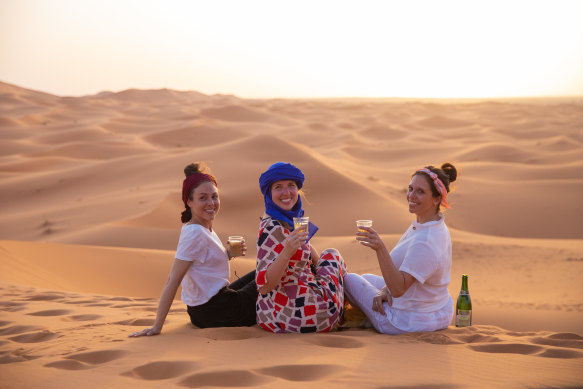
Intrepid offers trips to Morocco with inspirational locals.
It is the last night of an Intrepid tour that had taken us to the highest part of the Atlas Mountains, where we’ve met some of the inspirational women (and quite a few men) who Intrepid supports through the Intrepid Foundation and through the “positive impact tourism” it brings to the region. Our focus has been women’s enterprises and we’ve visited women’s carpet-making co-operatives, herbalists, restaurants and cooking schools with women at their centre.
Back in Marrakesh for a night, our farewell dinner is planned to give us a further insight into the daily life of Moroccan women. But we aren’t prepared for the radical joyousness of dinner at Zineb’s. And something else.
As we squeeze onto couches around a low table, drinking mint tea and over-indulging in some fantastic home cooking, we are entertained by a group of five women known as B’net Houariyat, who rowdily perform a kind of traditional music and dancing reserved for women called Houara, from this region near Marrakesh.
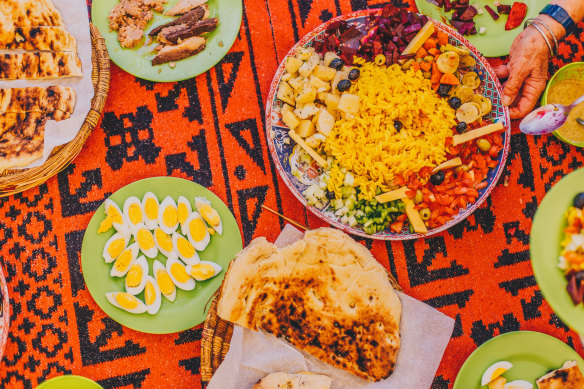
Food, and an abundance of it, is at the heart of hospitality here.
Using hand drums, castanets, raucous singing, and raunchy dance moves, the women sing about life, love, beauty, marriage and family grievances. They are badass, and we are all drawn into their exuberance, leaping to our feet and joining them in frenetic dancing once our meal is over. While there are two men in our group of eight (one is our guide, Brahim) the oestrogen is off the charts.
I haven’t had so much fun in years. It is a brilliant end to an engrossing week. We say our goodbyes and go back to our hotel in the newer part of Marrakesh.
About an hour later, the devastating earthquake of September 8, 2023 strikes.
Parts of the old medina have been reduced to rubble. Zineb is safe, we hear later, but her house has partly crumbled. A memorable Intrepid journey has just become more memorable, for the wrong reasons.
Six days earlier in Marrakesh, at the beginning of our journey, our small group bonds over dinner by the pool at the celebrated La Maison Arabe, a riad and restaurant that dates back to 1946. Sitting in the courtyard in the warm air, we are feted with the kind of extravagant feast that would be commonplace over the next few days, Moroccan hospitality being legendary. So much of daily life takes place over shared meals, that the centrepiece of everything we are about to do will involve breaking bread, literally, with locals.
The next morning, we head for the High Atlas Mountains, driving carefully from Marrakesh on winding roads which are in the process of being widened. It’s best not to look over the side – the craggy landscape gives way to perilous drops down steep ravines. Stalls selling sparkling chunks of minerals and clay tagines fill the rest stops and travellers head for the terrace restaurants that have spectacular views across the mountains.
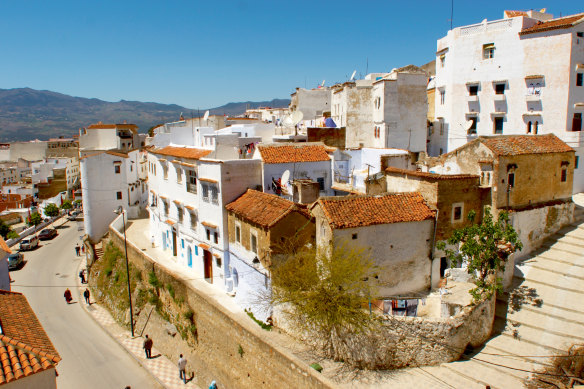
Terraces have spectacular views across the mountains.
Our first destination is the ksar, or fortified village, of Ait Benhaddou, with its clusters of rammed earth and clay brick towers that rise above a wide, dry riverbank. It looks like a movie set. And it is. The UNESCO World Heritage site dates to the 11th century, but modern audiences know it as a location for Gladiator, Game of Thrones, Lawrence of Arabia, and more than two dozen other Hollywood features. The locals are busily employed as extras, and in some ancient houses, they proudly post clippings of movie publicity over the walls.
At the foot of the ksar there’s a beautiful, tented tearoom run by a co-operative of more than 30 women – the Tawesna Association. Intrepid supports the initiative, which was created to generate income for village women who have traditionally not been allowed to earn their own money. We sit with founder Nadia Baa Bouz over a delicious lunch she and her friends have cooked in their simple kitchen. The women, many of them widows, not only seek a way to be independent through cooking but enjoy showcasing the culinary heritage of the Ouarzazate region. And they love a chat.

Friday night at the bazaar.
On the other side of the dry riverbed, we are shown around another women’s co-operative, the Akhnif carpet collective, where Berber women work on looms hand making the most beautiful and intricate carpets, including the fluffy, white, double-sided rugs that are currently fashionable. Each region has its own traditions and symbols and within the cool building there are rooms piled high with a treasure trove of unique carpets in every colour and pattern imaginable. Two members of our group choose carpets, but I would still be there now if I had to decide between so many gorgeous options.
That night we stay at a charming small hotel on the edge of the desert, Riad Ksar Ighnda, which is set in a flourishing garden oasis that incorporates part of an old, fortress village. The next day we set out for Imlil, a Berber village 1700 metres above sea level and a popular ski resort in winter.
Along the way, we stop at the women’s argan oil co-operative at Ait Tamnat. A group of seated women demonstrate the labour-intensive process behind grinding the nuts to make the oil that is now so prized for culinary and cosmetic purposes. Not only does the arduous work provide the women with a wage but cultivating the argan trees (indigenous to Morocco and the kind that goats love to climb) counteracts deforestation in the south-west of Morocco. A shop does brisk business selling face creams, soaps and oils, scented with orange flowers, jasmines and other delicate flowers.
Lunch that day is at the house of Mr Abdelghani, who has had a long association with Intrepid as one of its bus drivers. We’re ushered into the room the family reserves for guests (every home has one of these). It’s lined with couches around a low table and once again we’re served huge platters of delicious food. There seems to be no end to Moroccan generosity. As honoured guests, we’re served rfissa, a stew of chicken and lentils over shredded msemen flatbread, which is usually reserved to celebrate major family events such as births.
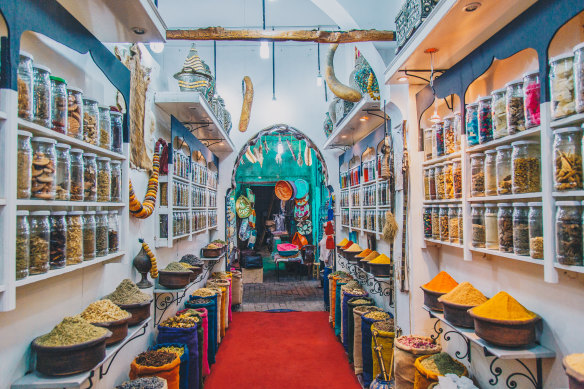
Spices for sale at a market in Marrakech.
In Imlil, our lodging for the night is Riad Jnane Imlil, a colourful, rustic hotel that’s terraced down the mountain, with views on every side of red peaks and green valleys and the tall minaret of the Imlil mosque. From my rather large room I can see North Africa’s highest peak, Mount Toubkal.
The next day, we trek across the valley to visit the home of the Armoud family, whose house and homey riad cascades down the steep hill, overlooking a wide, dry riverbed and small allotments of farms. We’re greeted with milk and dates, a typical Amazigh (Berber) offering to guests. The long room with its woven reed ceiling is lined with couches covered in bright rugs. While we lounge and gaze at the extraordinary view, we’re served a simple feast – this time freshly home baked bread, a salad of chopped vegetables, an omelette bubbling in a tagine dish and mint tea.
I’m again struck by the kindness and generosity at the heart of Berber culture and how tourism like ours is a way for families to preserve and showcase their traditions while making a living wage.
That night we stay in Ouirgane at Chez Momo, one of Morocco’s most beloved traditional Berber guesthouses. It’s built of stone and earthenware brick over several levels, set in gardens planted with roses, tumbling bougainvillea, and pots of spiky succulents, the beautiful rooms full of antique carpets, pottery and tiles, some with fireplaces. In this lower part of the Atlas, the view of the purple mountains is framed by olive groves, cyprus and palms. Our feast tonight is in the courtyard by the pool. Can you eat too many tagines? I don’t think so.
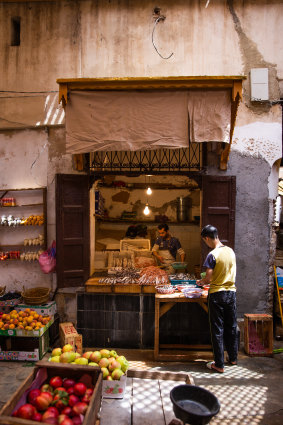
Fresh food in the medina.
After all this amazing food, we’re keen to know how to cook it. Celebrated local chef, Tarik Haribida, operates a cooking school, hospitality institute and restaurant set in a lush, meandering garden only 30 kilometres from Marrakesh. We sit on carpet-covered bales of hay learning the basics, then don red aprons and hats for hands-on cooking of delicious things such as sizzling chicken tagines and couscous, baked in clay pots over coals. Then we get to eat it all.
The feasts don’t stop now we’re back in the city. We have lunch in a pretty garden setting at the social gastronomy restaurant of the Amal Association Women’s Training Centre, a not-for-profit organisation that runs classes for women who want to become professional chefs or caterers. Women make up only 25 per cent of the workforce in Morocco and are largely underpaid and undervalued, so their skills as cooks is a way of harnessing the power of food to give them independence, just as it is with the women of the Tawesna Association we met in Ait Benhaddou. We’re there on a Friday, which is couscous day throughout Morocco. No one complains.
After dinner at Zineb’s that night, we are in our hotels in the modern part of the city when the earthquake strikes, it’s epicentre and the worst of it is in the Atlas Mountains near Imlil. We’re safe, although shaken, and spend most of the night on the street.
One of the advantages of travelling with Intrepid, which is intimately connected to communities throughout Morocco, is that we have on-the-spot intel about what is happening around the country, thanks to a network of guides and support staff. There is terrible news – Chez Momo, where we stayed the night before, has collapsed and there has been loss of life (the guesthouse has since reopened).
But there is good news, too – the families who gave us so much hospitality in the mountains have all survived, with minimum damage to their homes.
We’ve been nourished by wonderful home-cooked meals on this tour but what is most unforgettable is the resilience and warmth of our Berber hosts and Intrepid guides.
The details
Tour
Intrepid’s 15-day Premium Morocco in Depth, from city to the Sahara, starts at $4892 a person. The eight-day, woman only, Morocco: Women’s Expedition, from $1695. See Intrepidtravel.com.au
Fly
Emirates operates nine daily flights out of Australia to Dubai, connecting to Casablanca twice daily. See emirates.com
More
Support the women of Morocco through the Intrepid Foundation and its partner, the High Atlas Foundation. See theintrepidfoundation.org; highatlasfoundation.org/en
The writer was a guest of Intrepid Travel.
Sign up for the Traveller Deals newsletter
Get exclusive travel deals delivered straight to your inbox. Sign up now.